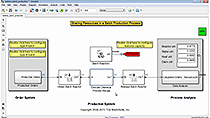Green Hydrogen Production in Microgrids
From the series: Microgrid System Development and Analysis
Overview
Production of green hydrogen by electrolysis is identified as an enabler for electrified transportation and fossil-free industrial processes. Electric power harvested from renewable energy sources (wind, solar) is converted into hydrogen gas. Despite the undoubted potential, planning, design and operation of electrolysis plants present several challenges. Join this MathWorks presentation to discover how physical system simulation can empower R&D engineering tasks ranging from performance analyses and controls development to techno-economic studies and deployment.
Highlights
- Physical multi-domain modeling and simulation
- Trade-off model fidelity versus simulation objective
- Micro-grid integration and techno-economic analysis
- Power electronics control design
- Options for sharing models such as Apps, FMU
- Please allow approximately 60 minutes to attend the presentation and Q&A session.
About the Presenters
Juan Sagarduy is a senior application engineer in the control design and automation field. His specific focus is physical multidomain modeling and simulation. In his role, Juan provides technical expertise for successful adoption of plant modeling tools (Simscape™ platform) for model-based development. In recent years, he has led several initiatives within Electrification for the Nordic region. Before joining MathWorks in 2011, Juan worked at the ABB Corporate Research Centre (Västerås, Sweden) in electrical machines and motion control projects. Juan holds an M.S. degree in industrial engineering (Bilbao, Spain) and a Ph.D. in electrical engineering from Cardiff University in the UK.
Tadele Shiferaw is an application engineer at MathWorks Benelux based in Eindhoven. He coordinates the engagement on power electronics design and control with customers from multiple industries within the Benelux area. His technical focus areas include physical modeling of systems, controller design, systems engineering and hardware-in-the loop simulations. Tadele completed a graduate study in control systems and a Ph.D. on controller design for safe robotic manipulation at University of Twente in the Netherlands.
Recorded: 30 Mar 2022




